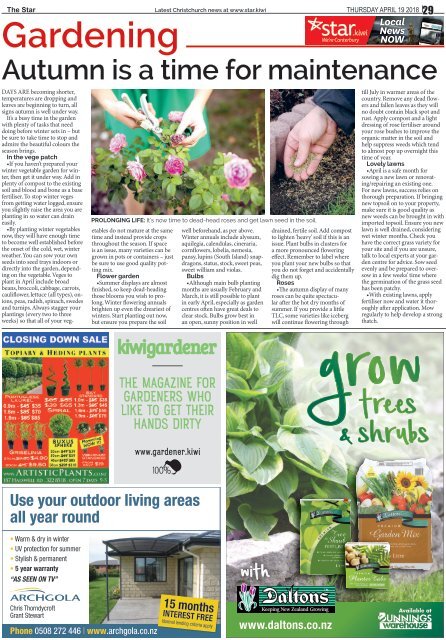The Star: April 19, 2018
You also want an ePaper? Increase the reach of your titles
YUMPU automatically turns print PDFs into web optimized ePapers that Google loves.
<strong>The</strong> <strong>Star</strong> 29<br />
Gardening<br />
Local<br />
News<br />
Now<br />
Latest Christchurch news at www.star.kiwi<br />
Thursday <strong>April</strong> <strong>19</strong> <strong>2018</strong><br />
Autumn is a time for maintenance<br />
Fire rages, homes at risk<br />
PROLONGING LIFE: It’s now time to dead-head roses and get lawn seed in the soil.<br />
DAYS ARE becoming shorter,<br />
temperatures are dropping and<br />
leaves are beginning to turn, all<br />
signs autumn is well under way.<br />
It’s a busy time in the garden<br />
with plenty of tasks that need<br />
doing before winter sets in – but<br />
be sure to take time to stop and<br />
admire the beautiful colours the<br />
season brings.<br />
In the vege patch<br />
•If you haven’t prepared your<br />
winter vegetable garden for winter,<br />
then get it under way. Add in<br />
plenty of compost to the existing<br />
soil and blood and bone as a base<br />
fertiliser. To stop winter veges<br />
from getting water logged, ensure<br />
you slightly raise the area you are<br />
planting in so water can drain<br />
easily.<br />
•By planting winter vegetables<br />
now, they will have enough time<br />
to become well established before<br />
the onset of the cold, wet, winter<br />
weather. You can sow your own<br />
seeds into seed trays indoors or<br />
directly into the garden, depending<br />
on the vegetable. Veges to<br />
plant in <strong>April</strong> include broad<br />
beans, broccoli, cabbage, carrots,<br />
cauliflower, lettuce (all types), onions,<br />
peas, radish, spinach, swedes<br />
and turnips. Always stagger your<br />
plantings (every two to three<br />
weeks) so that all of your vegetables<br />
do not mature at the same<br />
time and instead provide crops<br />
throughout the season. If space<br />
is an issue, many varieties can be<br />
grown in pots or containers – just<br />
be sure to use good quality potting<br />
mix.<br />
Flower garden<br />
•Summer displays are almost<br />
finished, so keep dead-heading<br />
those blooms you wish to prolong.<br />
Winter flowering annuals<br />
brighten up even the dreariest of<br />
winters. <strong>Star</strong>t planting out now,<br />
but ensure you prepare the soil<br />
<strong>The</strong> magazine for<br />
gardeners who<br />
like To geT <strong>The</strong>ir<br />
hands dirTy<br />
www.gardener.kiwi<br />
100%<br />
well beforehand, as per above.<br />
Winter annuals include alyssum,<br />
aquilegia, calendulas, cineraria,<br />
cornflowers, lobelia, nemesia,<br />
pansy, lupins (South Island) snapdragons,<br />
status, stock, sweet peas,<br />
sweet william and violas.<br />
Bulbs<br />
•Although main bulb planting<br />
months are usually February and<br />
March, it is still possible to plant<br />
in early <strong>April</strong>, especially as garden<br />
centres often have great deals to<br />
clear stock. Bulbs grow best in<br />
an open, sunny position in well<br />
drained, fertile soil. Add compost<br />
to lighten ‘heavy’ soil if this is an<br />
issue. Plant bulbs in clusters for<br />
a more pronounced flowering<br />
effect. Remember to label where<br />
you plant your new bulbs so that<br />
you do not forget and accidentally<br />
dig them up.<br />
Roses<br />
•<strong>The</strong> autumn display of many<br />
roses can be quite spectacular<br />
after the hot dry months of<br />
summer. If you provide a little<br />
TLC, some varieties like iceberg<br />
will continue flowering through<br />
till July in warmer areas of the<br />
country. Remove any dead flowers<br />
and fallen leaves as they will<br />
no doubt contain black spot and<br />
rust. Apply compost and a light<br />
dressing of rose fertiliser around<br />
your rose bushes to improve the<br />
organic matter in the soil and<br />
help suppress weeds which tend<br />
to almost pop up overnight this<br />
time of year.<br />
Lovely lawns<br />
•<strong>April</strong> is a safe month for<br />
sowing a new lawn or renovating/repairing<br />
an existing one.<br />
For new lawns, success relies on<br />
thorough preparation. If bringing<br />
new topsoil on to your property,<br />
make sure it is good quality as<br />
new weeds can be brought in with<br />
imported topsoil. Ensure you new<br />
lawn is well drained, considering<br />
wet winter months. Check you<br />
have the correct grass variety for<br />
your site and if you are unsure,<br />
talk to local experts at your garden<br />
centre for advice. Sow seed<br />
evenly and be prepared to oversow<br />
in a few weeks’ time where<br />
the germination of the grass seed<br />
has been patchy.<br />
•With existing lawns, apply<br />
fertiliser now and water it thoroughly<br />
after application. Mow<br />
regularly to help develop a strong<br />
thatch.<br />
grow<br />
trees<br />
& shrubs<br />
Use your outdoor living areas<br />
all year round<br />
• Warm & dry in winter<br />
• UV protection for summer<br />
• Stylish & permanent<br />
• 5 year warranty<br />
“AS SEEN ON TV”<br />
with<br />
Chris Thorndycroft<br />
Grant Stewart<br />
Phone 0508 272 446 | www.archgola.co.nz<br />
15 months<br />
INTEREST FREE<br />
Normal lending criteria apply


















